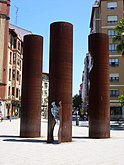You can help expand this article with text translated from the corresponding article in Spanish. (August 2014) Click [show] for important translation instructions.
|
Barakaldo (Spanish: Baracaldo; Basque: Barakaldo [baɾakalðo]) is a municipality located in the Biscay province in the Basque Country in Spain. Located on the Left Bank of the Estuary of Bilbao, the city is part of Greater Bilbao, has a population as of the 2019 census[update] at 100,881.[3] Barakaldo has an industrial river-port heritage and has undergone significant redevelopment with new commercial and residential areas replacing the once active industrial zones.
Barakaldo
| |
|---|---|
| Coordinates: 43°17′50″N 2°59′30″W / 43.29722°N 2.99167°W | |
| Country | |
| Autonomous community | Basque Country |
| Province | Biscay |
| Comarca | Greater Bilbao |
| Founded | pre 1051 |
| Government | |
| • Mayoress | Amaia del Campo Berasategi (2015-Today) (PNV) |
| Area | |
| • Total | 25.03 km2 (9.66 sq mi) |
| Elevation | 39 m (128 ft) |
| Highest elevation | 560 m (1,840 ft) |
| Lowest elevation | 0 m (0 ft) |
| Population (2018)[2] | |
| • Total | 100,435 |
| • Density | 4,000/km2 (10,000/sq mi) |
| Demonym(s) | baracaldés, -sa |
| Time zone | UTC+1 (CET) |
| • Summer (DST) | UTC+2 (CEST) |
| Postal code | 48900, 48901, 48902 and 48903 |
| Dialing code | 94 |
| Website | Official website |
History edit
The 1911 Encyclopædia Britannica[4] original entry on the town stated:
"Pop.(1900): 15,013. Few Spanish towns have developed more rapidly than Baracaldo [sic], which nearly doubled its population between 1880 and 1900. During this period many immigrant labourers settled here; for the iron works and dynamite factory of Baracaldo prospered greatly, owing to the increased output of the Biscayan mines, the extension of railways in the neighbourhood, and the growth of shipping at Bilbao. The low flat country round Barakaldo is covered with maize, pod fruit and vines".
Iron mining formed a large part of Barakaldo's industry, making it the endpoint of a mining railway. The steel industry, led by Altos Hornos de Vizcaya, had an important presence during the 20th century, until the industrial recession hit the region's economy in the 1980s.
In recent decades, the industrial zones surrounding Barakaldo have become less prominent, which can be owed to the shuttering of large companies such as Babcock & Wilcox. Although several factories remain, areas that were once industrial have been redeveloped into residential properties such as malls and parks. A large exhibition centre. the Bilbao Exhibition Centre has recently been built on the outskirts of the town.
Transport edit
Barakaldo is connected to the rest of the Greater Bilbao metropolitan area by Line 2 of the Metro Bilbao. Four stations are in the city: Gurutzeta/Cruces, Ansio, Barakaldo and Bagatza). The Cercanías Bilbao train line has two stations in Barakaldo (Lutxana and Desertu-Barakaldo). BizkaiBus company provides a bus service, with connections to the rest of Biscay.
Locally, an urban bus system named Kbus operates with two lines. A tram line has been proposed to connect local districts.
The main motorway is the A-8 motorway, which also goes between Bilbao. It serves as the main road link between Greater Bilbao and the rest of Spain.
A boat ferry service connects Barakaldo to the other side of the Estuary of Bilbao in Erandio. Barakaldo is located 15 kilometres (9.3 mi) from Bilbao Airport.
Demographics edit
Population peaked in the 1990s to over 100,300. The decline of local industry decreased the population, though, and in 2002, 95,000 people lived in Barakaldo. However, a recent increase has sent the population to 100,502 residents.[citation needed]
Tourism edit
Tourists visit sites in Barakaldo such as the Botanic Garden, the Bilbao Exhibition Centre, the medieval Bridge of Castrexana, and some of the city's street sculptures.[5] In July, the town celebrates "Las Fiestas del Carmen," which includes open-air concerts and large fairs.[6]
Sports edit
Barakaldo is represented by the Barakaldo Club de Fútbol in Spain's Segunda División B. They play home games at the Estadio Nuevo Lasesarre. A second team, SD Retuerto Sport, plays in Tercera División. Local league teams include Gurutzeta KFT, UD Burtzeña, Pauldarrak FKT, Zuazo C.F. and S.C.D. Dosa-Salesianos.
Handball has played a part in Barakaldo's tradition. Now[when?], two teams are present in competitions: Club Balonmano Zuazo Femenino, playing in División de Honor Femenina de Balonmano, and Club Balonmano Barakaldo who plays in the Liga ASOBAL.
Bizkaia Arena is an indoor arena with a capacity of 18,640. It hosted some games of the 2014 FIBA Basketball World Cup.
Notable natives edit
- Asier del Horno, footballer
- Carlos Sobera, actor
- David López, cyclist
- Iñaki Lafuente, footballer
- Javier Clemente, football manager
- Javier González Gómez, footballer
- Javier Otxoa, cyclist
- Josep Lluís Núñez, president of FC Barcelona between 1978 and 2000
- Unai Expósito, footballer
- Antonio Iturmendi Bañales, politician
- Maisha MC, musician
- Lucía García, footballer
- Esty Quesada, youtuber and podcaster
See also edit
- Barakaldo D.F., a Mägo de Oz concert DVD filmed in Barakaldo
References edit
- ^ Instituto Vasco de Estadística, ed. (2005). "Extensión superficial y altitud por ámbitos territoriales". Retrieved 10 February 2009.
- ^ Municipal Register of Spain 2018. National Statistics Institute.
- ^ Instituto Nacional de Estadistica, Madrid.
- ^ Chisholm 1911.
- ^ "Barakaldo Official Tourism Web (In English)". Archived from the original on 2013-03-08. Retrieved 2013-03-25.
- ^ Carmenes de Baracaldo, 2001, retrieved May 12, 2020
External links edit
- Chisholm, Hugh, ed. (1911). . Encyclopædia Britannica. Vol. 3 (11th ed.). Cambridge University Press. p. 379.
- www.i-barakaldo.com Archived 2011-11-23 at the Wayback Machine La comunidad virtual de Barakaldo
- Official website (in Basque / Spanish)
- BARAKALDO in the Bernardo Estornés Lasa - Auñamendi Encyclopedia (Euskomedia Fundazioa) (in Spanish)








